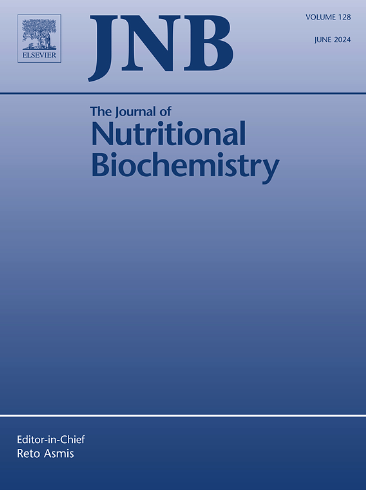限时喂养可通过提高FGF21的敏感性来减轻hfd诱导的衰老小鼠肌少性肥胖。
IF 4.8
2区 医学
Q1 BIOCHEMISTRY & MOLECULAR BIOLOGY
引用次数: 0
摘要
限时喂养(TRF)是一种饮食干预,已被证明对健康有许多好处。然而,进一步研究TRF在治疗肌肉减少性肥胖(SO)方面的潜在有效性是很重要的。SO的特征是年龄相关性肥胖和肌肉减少症的结合。在本研究中,14月龄的C57BL/6J雄性小鼠被喂食常规饲料或高脂肪饲料(HFD),每天进食8小时(干预7个月)。在人体试验(ChiCTR2100052876)中,招募了体重指数≥28的肥胖个体(n=21),并指导他们采用8小时进食窗口期和16小时禁食期。在这里,我们发现TRF干预显著降低了整体脂肪量(p本文章由计算机程序翻译,如有差异,请以英文原文为准。

Time-restricted feeding mitigates HFD-induced sarcopenic obesity in aging mice through improving the sensitivity of FGF21
Time-restricted feeding (TRF) is a dietary intervention that has been shown to have numerous health benefits. However, it is important to further investigate the potential effectiveness of TRF in addressing sarcopenic obesity (SO), which is characterized by a combination of age-related obesity and sarcopenia. In this study, 14-month-old C57BL/6J male mice were fed either regular chow diet or high-fat diet (HFD), and had either ad libitum or restricted access to food for 8 hours daily (Intervention for 7 months). For the human trial (ChiCTR2100052876), obese individuals (n=21) with a Body Mass Index ≥28 were recruited and instructed to adopt an 8-hour eating window and a 16-hour fasting period. Here, we found that the TRF intervention significantly reduced global fat mass (P < .001) and volume (P < .05), and increase lean mass compared to mice fed with HFD. Furthermore, TRF improved overall metabolic mobility (8h TRF+HFD vs. AL+HFD). This intervention also enhanced liver FGF21 protein levels (P < .01) and the expression of FGFR1 and FGF21 target genes in adipose and muscle tissues, thus improving mitochondrial quality control in these tissues. Notably, TRF interventions led to a significant decrease in serum FGF21 levels (P < .05). In the human trial, TRF intervention resulted in a significant reduction in weight (P < .001) and body fat levels (P < .001) among obese individuals, as well as a decrease in serum GLU (P < .001), insulin (P < .001), and TC levels (P < .05). Overall, the findings indicate that TRF intervention improves SO by regulating liver FGF21 expression, thereby enhancing FGF21 sensitivity in adipose and muscle tissues.
求助全文
通过发布文献求助,成功后即可免费获取论文全文。
去求助
来源期刊

Journal of Nutritional Biochemistry
医学-生化与分子生物学
CiteScore
9.50
自引率
3.60%
发文量
237
审稿时长
68 days
期刊介绍:
Devoted to advancements in nutritional sciences, The Journal of Nutritional Biochemistry presents experimental nutrition research as it relates to: biochemistry, molecular biology, toxicology, or physiology.
Rigorous reviews by an international editorial board of distinguished scientists ensure publication of the most current and key research being conducted in nutrition at the cellular, animal and human level. In addition to its monthly features of critical reviews and research articles, The Journal of Nutritional Biochemistry also periodically publishes emerging issues, experimental methods, and other types of articles.
 求助内容:
求助内容: 应助结果提醒方式:
应助结果提醒方式:


